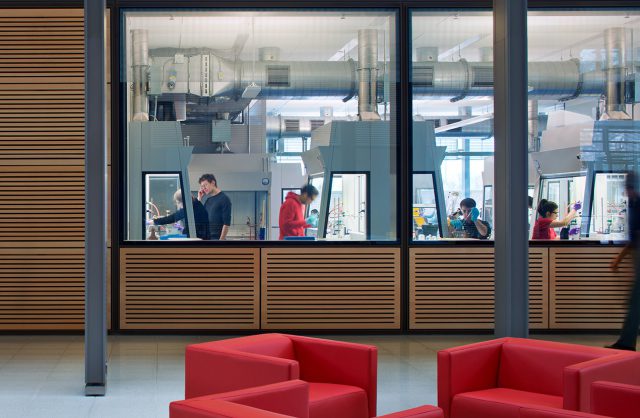The design of this highly specialized, one-of-a-kind geochemistry research building was driven by a unique cross-sectional configuration. The result is not only a highly efficient, low-impact design, but also an organization that significantly increases social and scientific collaboration of its occupants. Departing from the recommendation of the campus master plan, the building was placed on an existing parking lot site, downhill from the center of campus, to minimize land disturbance and preserve trees.

Columbia University
Gary C. Comer Geochemistry Building
Project Statistics
LOCATION
Palisades, NY / United States
COMPLETED
2008
TOTAL SQUARE FOOTAGE
70,000 GSF
PROGRAM COMPONENTS
Geochemistry
LEED STATUS
LEED-NC 2.2 Silver Certified
AWARDS
IN THE NEWS
TEAM
James H. Collins, Jr., FAIA, LEED AP
Principal-in-Charge
Charles S. Klee, AIA, LEED AP
Project Manager
Peter F. Vieira, FAIA, LEED AP
Project Architect
Leon Auvil Jr., AIA, CSI, CDT
Architect
Marceli Botticelli
Designer
Mary Gallagher, IIDA, LEED AP
Interior Designer
PROJECT EUI
Skip-Stop Layout
Seizing on the imbalance between required office and laboratory spaces as an opportunity to create a highly sustainable massing strategy, a three story wing of offices (10 feet in height) is coupled with a two story wing of laboratories (15 feet in height) of approximately equal length. The resultant “skip stop” arrangement consumes 19% less footprint and 13% less volume than the two story building first envisioned, significantly reducing the quantity of materials used in the building. The lab side is a high energy environment with complex technical systems; the office side is a low tech structure with operable windows and individually controlled heating and cooling.
Social Engine of Scientific Collaboration
The building’s external form reflects its internal organization. The central spine rises gently above the adjacent rooflines to form a protective canopy. Gabion foundation walls recall nearby rock outcroppings. Two covered decks at the building’s far end, overlooking the Hudson River Valley, acknowledge the research community’s fondness for the outdoors. A rustic timber stair leads to a popular network of hiking trails, which traverse the region’s scenic promontories.
Not only do the offices enjoy an abundance of natural sunlight, but the ability to pause for a moment and gaze into the woods provides a significant measure of relief to highly-stressed scientists.
ROBERT F. ANDERSON, DIRECTOR, GEOCHEMISTRY DIVISION, COLUMBIA UNIVERSITY, LDEO
Photography: © Peter Vanderwarker; © Warren Jagger Photography























